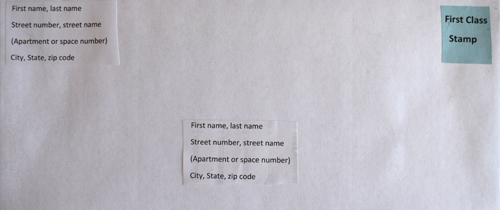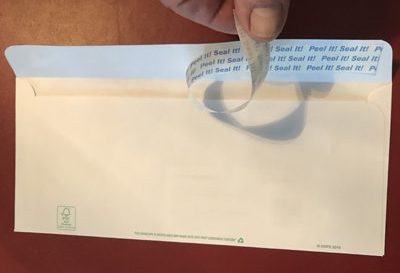To make a self-addressed, stamped envelope, (also called a SASE) you take an empty envelope, and in the center of the front side you write (print) your mailing address: your name, street number, street address (apartment or space number), city, state and zip code.
(To find your zip code go to: https://tools.usps.com/go/ZipLookupAction!input.action )
You do not need to put the name of the county (for example, Santa Clara County) you live in.
In the upper right hand corner of the front side of the envelope you put a United States Postal Service stamp with the appropriate amount of postage.
(Current domestic postage rates are at: https://www.usps.com/business/prices.htm )
If you want your SASE to go to an address out of the United States you must add more postage and add the name of the country to the address.
You can also put your mailing address in the upper left hand corner of the envelope.
SASEs are used, for example, in a Red Cross class when the instructor will be printing the certification cards (or ordering them) and mailing them to the individuals who earned the certifications in the class, but the cards are not available until after the class is completed.
Simple enough, but sometimes people make mistakes with them.
Some of these mistakes can cause your SASE to not get to you, and even to be lost forever.
People can be so used to addressing envelopes that they put their “return” mailing address in the upper left hand corner, put a stamp in the upper right hand corner, but do not put any address in the center of the front of the envelope, leaving that space blank. That space, the center of the front, is for the recipient’s name and address, and since you will be the recipient, your name / address must be there.
Some people do not write in handwriting that is easily readable.
In the Red Cross certification classes I teach, many students do not use postal service mail, but text and email each other instead.
— One time a student brought an envelope, properly addressed, but with only a two cent stamp on it, not sufficient postage.
— Another wrote her name and street address on the envelope, but no city /state, and in her case, the street name was used in three local cities.
The size of the envelope can be important. A Red Cross certification card is the size of a credit card, so you do not need a big envelope. A “standard” (sometimes described as #10 size, usually about 4 1/8 inches by 9 ½ inches) business mailing envelope will be fine. And if you use a large, 9 inch by 12 inch heavy-duty envelope it may need more postage than you put on it.
But, for example, if you are asking someone to send you a CD, you will need a larger envelope than pictured at this webpage, and potentially more postage. If you want to be sent a document or photo that is 8 1/2 inches X 11 inches, and you want it to come to you unfolded, you will need a 9 inch by 12 inch envelope, and again, maybe more postage.
To seal the envelope shut, each envelope will have a wide or triangular section of the of the envelope on the top of the back side that folds down over the envelope. It will have a strip of adhesive on the edge of it that can be moistened and pressed down on the envelope after whatever it is you want to mail has been put in the envelope. Some people dig around in their office supplies and find an envelope that they do not realize is quite old. The adhesive may have dried up so completely that it can’t be moistened and made to stick shut. Or the adhesive may have gotten moist and be already stuck to the envelope.
The best kind of envelope to use is a relatively-new-one with a “peel off to close” also called “clean seal” and “fast, easy closure” strip on the top of the fold-down section at the back. The person mailing you something puts it in the envelope, peels off a thin strip of paper covering the built-in adhesive and secures the envelope. This type is much more likely to stay sealed so the certification card will not fall out of the envelope.
– – – Sometimes a student in my Red Cross certification classes will bring a box of the better-quality envelopes and stamps to share with other students. Almost everyone remembers to bring their SASE before the last day of class, but there are some people who forget and are grateful to have an envelope and stamp supplied to them.
– In one case a student had recently moved and did not know his new mailing address. He knew where his apartment was and the apartment number, but had no idea of the street (mailing) address. He needed to call first one, then another of his roommates at the end of class, and a couple of the young women in the class ended up giggling at him. He blushed vividly.
The person mailing you your certificate will probably just put the envelope in a mailbox. You should not expect them to make trip to the post office and stand in line to pay a fee for Certified Mail, Return Receipt or tracking.

